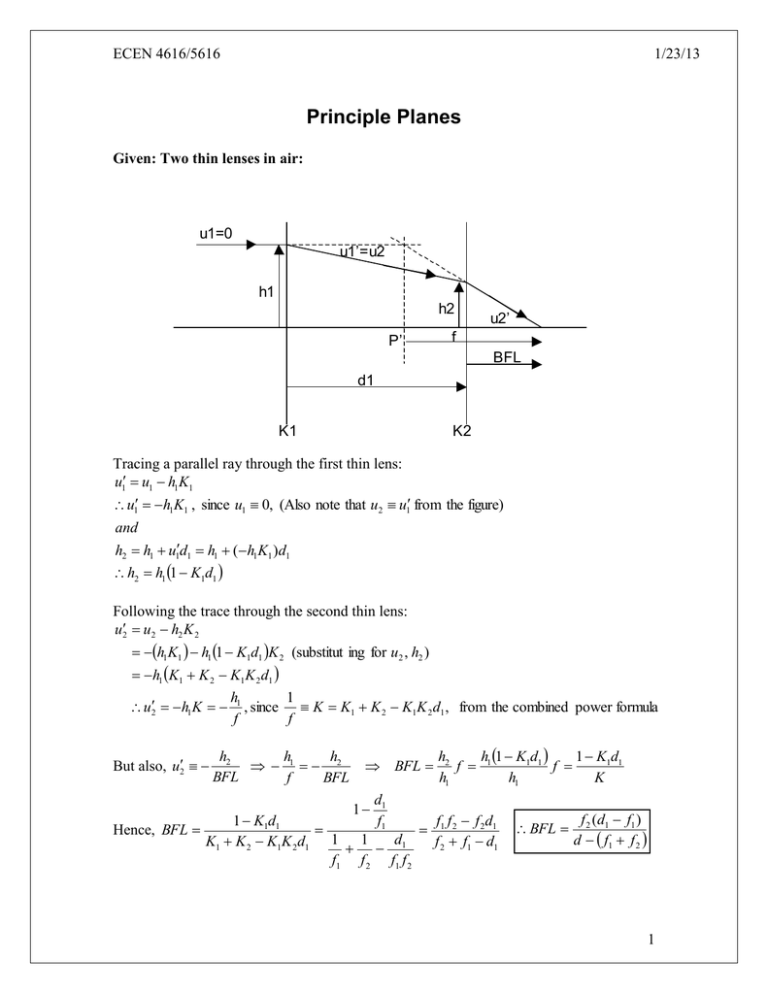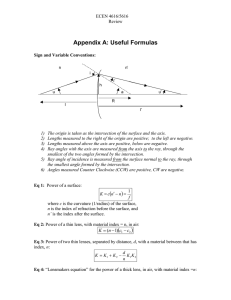04a) Principle Planes_1_23.docx
advertisement

ECEN 4616/5616 1/23/13 Principle Planes Given: Two thin lenses in air: u1=0 u1’=u2 h1 h2 P’ u2’ f BFL d1 K1 K2 Tracing a parallel ray through the first thin lens: u1 u1 h1K1 u1 h1K1 , since u1 0, (Also note that u2 u1 from the figure) and h2 h1 u1d1 h1 (h1K1 )d1 h2 h1 1 K1d1 Following the trace through the second thin lens: u2 u2 h2 K 2 h1K1 h1 1 K1d1 K 2 (substitut ing for u2 , h2 ) h1 K1 K 2 K1K 2 d1 u2 h1K But also, u2 h1 1 , since K K1 K 2 K1K 2 d1 , from the combined power formula f f h2 h h 1 2 BFL f BFL BFL 1 Hence, BFL d1 f1 h2 h 1 K1d1 1 K1d1 f 1 f h1 h1 K 1 K1d1 f f f 2 d1 1 2 K1 K 2 K1K 2 d1 1 1 d1 f 2 f1 d1 f1 f 2 f1 f 2 BFL f 2 (d1 f1 ) d f1 f 2 1 ECEN 4616/5616 1/23/13 The location of the principle plane, P’, measuring from the last element is: h h 1 K1d1 h Kd BFL f 2 f f 2 1 f 1 1 f K1d1 f 1 1 h1 h1 K h1 d1 d1 f f1 1 1 1 1 d 1 f f1 f 2 f1 f 2 Hence : f 2 d1 d1 f1 f 2 Principle Planes – Multiple Components: Seeking closed-form expressions for the principle planes and BFL of more complex systems is a task of increasing difficulty and diminishing returns. It is easier to use the results of a Gaussian ray trace to define these quantities. A convenient coordinate system for this is to use the 1st and last surfaces, since their positions are usually accessible to measure from. Forward Trace: del’ h1 hk P’ uk’ f BFL S1 uk h1 f f h1 uk Sk also : uk hk h h h k f k 1 f uk uk uk 2 ECEN 4616/5616 h1 hk uk Backward Trace: Hence: 1/23/13 (Note that: BFL=f+’) del uk’ hk h1 u1 f’ P S1 u1 hk f Hence: f hk u1 also : u1 Sk h1 f h1 h h f 1 k u1 u1 u1 hk h1 u1 3 ECEN 4616/5616 1/23/13 “Principle Planes are Unit Magnification Conjugates” It is claimed that each principle plane is the one-to-one image of the other. How is this true? First, it is not true that an object inside the lens at P would be imaged to P’ or viceversa: S1 S2 1/K2 P P’ Image of object at P is magnified, and not at P’ However, a virtual object at P from object space (left) is seen as a virtual image at P’ from image space (right). First, draw the two rays that locate P, P’: ray 1 ray 2 P P’ P’ 4 ECEN 4616/5616 1/23/13 Next, realizing that, for optical systems in our approximations, rays have the exact same path regardless of which way they traverse the system – draw both rays as traveling from left to right (object space to image space): ray 1 ray 2 Q P ray 2 Q’ P’ P’ ray 1 Hence: Rays converging on point Q from the object space appear, in the image space, to diverge from point Q’, and vice-versa. Hence, Q’ is a virtual image of the virtual object, Q. This will be true regardless of the height that the rays are drawn – therefore plane P’ is an unmagnified image of plane P and vice-versa. Definitions: Virtual image point: Rays appear to diverge from a point that they don’t actually come from. Virtual object point: Rays converge towards a point that they don’t actually reach. 5 ECEN 4616/5616 1/23/13 Two Positive lenses equivalent to a negative lens: d=f1+2 f2 L1 h1 L2 2f2 f1 2f2 h2 K1>0 del P’ K2>0 Although both lenses are positive, the ray trace indicates that the net power is negative, and the output principle plane is far to the right of the system. The system can be replaced by the following equivalent: h1 f K<0 Putting d into the two-lens power equation: 1 2 d f1 2 f 2 K1 K 2 1 2 K1 K 2 K 2 2 K1 K1 K K1 K 2 K1K 2 K1 K 2 or f f1 6 ECEN 4616/5616 1/23/13 Solving for the principle plane location (Note that h2 h1 , u2 h1 h1 ): f f1 h1 h2 2h1 i.e., as far to the right of L2 as L2 is right of L1. 2 f1 h1 u2 f1 Notice that the focal length of L2 does not enter into the calculations of either the overall focal length or the principle plane – it only acts to convert L1 to a negative lens. Question: Can 2 negative lenses be arranged so as to be equivalent to a positive lens? Telephoto Lens: A telephoto lens is often assumed to be just a long focal length camera lens. It is that, but to call a lens “telephoto” it must have a physical length less than its focal length. This is convenient for hand-held cameras: I have a 400 mm telephoto lens that is only 200 mm long, for a “telephoto ratio” of 1:2. f P’ L The telephoto ratio is defined as the physical length of the lens divided by the focal length, L/f. This is used to reduce the physical size of long f.l. lenses. 7 ECEN 4616/5616 1/23/13 Inverse Telephoto Lens: This is the inverse of the telephoto, as one would expect. The goal here is to allow a very short f.l. lens – say a wide angle or macro lens – to have enough BFL to be compatible with shutters, standard mounts, etc. f P’ BFL L 8





